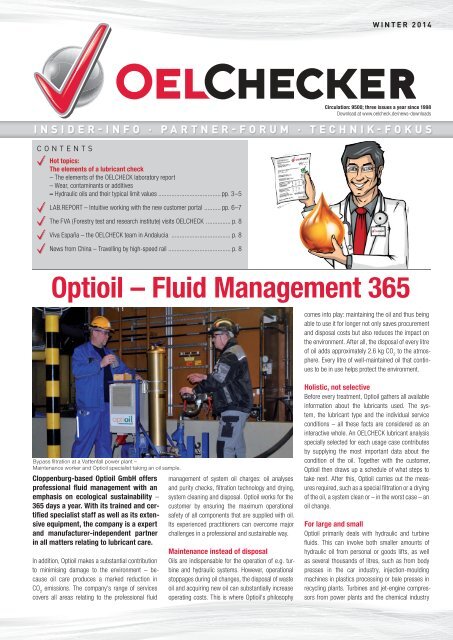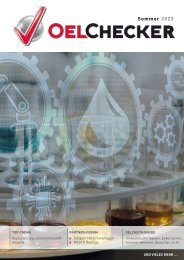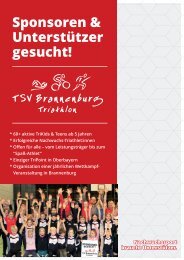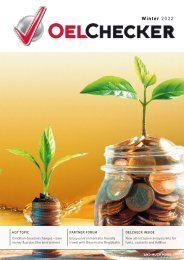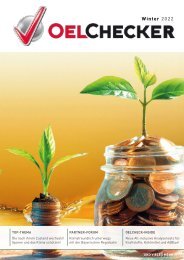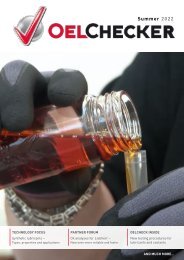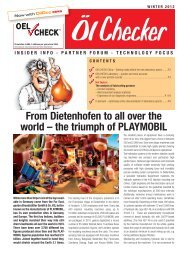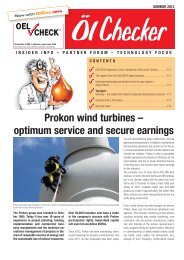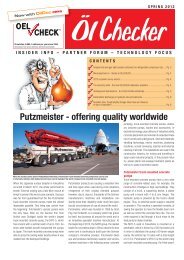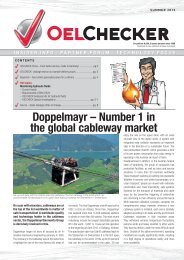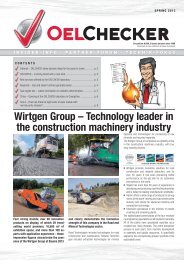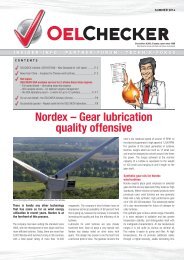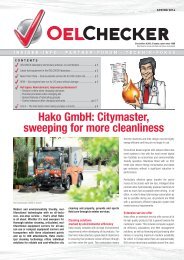OELCHECKER - Winter 2014
> Hot Topics: The elements of a lubricant check > The elements in the OELCHECK laboratory report > Wear, impurities or additives > Hydraulic oils and their typical limit values > LAB.REPORT – Intuitive working with the new customer portal > The FVA (Forestry test and research institute) visits OELCHECK > Viva España – the OELCHECK team in Andalucia > News from China – Travelling by high-speed rail
> Hot Topics: The elements of a lubricant check
> The elements in the OELCHECK laboratory report
> Wear, impurities or additives
> Hydraulic oils and their typical limit values
> LAB.REPORT – Intuitive working with the new customer portal
> The FVA (Forestry test and research institute) visits OELCHECK
> Viva España – the OELCHECK team in Andalucia
> News from China – Travelling by high-speed rail
You also want an ePaper? Increase the reach of your titles
YUMPU automatically turns print PDFs into web optimized ePapers that Google loves.
WINTER <strong>2014</strong><br />
Circulation: 9500; three issues a year since 1998<br />
Download at www.oelcheck.de/news-downloads<br />
CONTENTS<br />
Hot topics:<br />
The elements of a lubricant check<br />
– The elements of the OELCHECK laboratory report<br />
– Wear, contaminants or additives<br />
– Hydraulic oils and their typical limit values ...................................... pp. 3–5<br />
LAB.REPORT – Intuitive working with the new customer portal .......... pp. 6–7<br />
The FVA (Forestry test and research institute) visits OELCHECK ............... p. 8<br />
Viva España – the OELCHECK team in Andalucia .................................... p. 8<br />
News from China – Travelling by high-speed rail ...................................... p. 8<br />
Optioil – Fluid Management 365<br />
comes into play: maintaining the oil and thus being<br />
able to use it for longer not only saves procurement<br />
and disposal costs but also reduces the impact on<br />
the environment. After all, the disposal of every litre<br />
of oil adds approximately 2.6 kg CO 2<br />
to the atmosphere.<br />
Every litre of well-maintained oil that continues<br />
to be in use helps protect the environment.<br />
Bypass fi ltration at a Vattenfall power plant –<br />
Maintenance worker and Optioil specialist taking an oil sample.<br />
Cloppenburg-based Optioil GmbH offers<br />
professional fluid management with an<br />
emphasis on ecological sustainability –<br />
365 days a year. With its trained and certified<br />
specialist staff as well as its extensive<br />
equipment, the company is a expert<br />
and manufacturer-independent partner<br />
in all matters relating to lubricant care.<br />
In addition, Optioil makes a substantial contribution<br />
to minimising damage to the environment – because<br />
oil care produces a marked reduction in<br />
CO 2<br />
emissions. The company‘s range of services<br />
covers all areas relating to the professional fluid<br />
management of system oil charges: oil analyses<br />
and purity checks, filtration technology and drying,<br />
system cleaning and disposal. Optioil works for the<br />
customer by ensuring the maximum operational<br />
safety of all components that are supplied with oil.<br />
Its experienced practitioners can overcome major<br />
challenges in a professional and sustainable way.<br />
Maintenance instead of disposal<br />
Oils are indispensable for the operation of e.g. turbine<br />
and hydraulic systems. However, operational<br />
stoppages during oil changes, the disposal of waste<br />
oil and acquiring new oil can substantially increase<br />
operating costs. This is where Optioil‘s philosophy<br />
Holistic, not selective<br />
Before every treatment, Optioil gathers all available<br />
information about the lubricants used. The system,<br />
the lubricant type and the individual service<br />
conditions – all these facts are considered as an<br />
interactive whole. An OELCHECK lubricant analysis<br />
specially selected for each usage case contributes<br />
by supplying the most important data about the<br />
condition of the oil. Together with the customer,<br />
Optioil then draws up a schedule of what steps to<br />
take next. After this, Optioil carries out the measures<br />
required, such as a special filtration or a drying<br />
of the oil, a system clean or – in the worst case – an<br />
oil change.<br />
For large and small<br />
Optioil primarily deals with hydraulic and turbine<br />
fluids. This can involve both smaller amounts of<br />
hydraulic oil from personal or goods lifts, as well<br />
as several thousands of litres, such as from body<br />
presses in the car industry, injection-moulding<br />
machines in plastics processing or bale presses in<br />
recycling plants. Turbines and jet-engine compressors<br />
from power plants and the chemical industry
Our industry and the economy are on the threshold of the fourth<br />
industrial revolution. Production is becoming highly flexible.<br />
Through the introduction of self-optimisation, self-configuration<br />
and cognition processes, the automation technology needed for<br />
this has to become more intelligent and do more to support people<br />
in their increasingly complex work. At the same time, the real and<br />
virtual worlds are increasingly merging into an ‚internet of things‘.<br />
The use of mobile, smart devices will quite soon overtake that of<br />
stationary ones. In addition to the popular smartphones, ‚intelligent<br />
objects‘ are increasingly helping us in our everyday lives.<br />
For us at OELCHECK, the new era has already long begun. The automation technology in our<br />
laboratory is state-of-the-art. It makes the work of our staff easier and at the same time ensures<br />
that processes for the examination of samples and data management are even more reliable.<br />
The ground-breaking new version of our www.lab.report online portal means big changes for our<br />
customers as well.. Even for apparently simple processes like taking an oil sample, self-optimisation,<br />
self-configuration and cognition are the name of the game. And with your mobile devices and our QR<br />
codes on your machines, you already have access to the small intelligent objects that will make your<br />
working life easier, and not only when working directly with the machines. Welcome to the digital<br />
service world of OELCHECK!<br />
Last-minute rescue<br />
One German-based company that regularly uses<br />
Optioil‘s services is Vattenfall – one of Europe‘s<br />
largest energy producers. In one Vattenfall power<br />
plant, consistent monitoring of the oil in a gas turbine<br />
has already more than paid for itself. In the<br />
summer <strong>2014</strong>, the turbine oil was examined as a<br />
precautionary measure for possible deposits using<br />
an OELCHECK MPC test. The MPC index ascertained<br />
was extremely high.<br />
An immediate danger therefore for the 17,000 l of<br />
turbine oil and the gas turbine‘s operational safety!<br />
However, Optioil knew what to do. Instead of a<br />
costly system clean and the resulting stoppage, a<br />
special varnish filtration technology was deployed<br />
that, acting as a kind of artificial ‚kidney‘, was<br />
used to continually remove the contamination. The<br />
values of the oil were constantly monitored in the<br />
OELCHECK laboratory, and when, after only four<br />
weeks of by-pass filtration, the MPC index had<br />
fallen to an impressive 7.5, the proof was in: the<br />
varnish filtration technology deployed by Optioil had<br />
proved its effectiveness.<br />
Yours, Barbara Weismann<br />
will work in a highly efficient manner and under<br />
extreme continuous loads. Optioil monitors and<br />
maintains the turbine oils, thus ensuring the systems‘<br />
reliable availability.<br />
Support from OELCHECK<br />
The specialists of Optioil have been familiar with<br />
OELCHECK for years. They use the lubricant anal-<br />
oil circulation systems, often for several years. This<br />
can result in the depletion of additives or the formation<br />
of ageing products in the oil. Without careful<br />
monitoring through trend analyses, sludge-generating<br />
contaminants or adhesive reaction products<br />
remain undiscovered for a long time. ‚Varnish‘ can<br />
be deposited on control valves and plain bearings,<br />
and reduce the flow of oil or accumulate as oil<br />
sludge in oil-bearing pipes or in the tank. Optioil<br />
minimises the risk with regular trend analyses, and<br />
in particular OELCHECK‘s MPC test.<br />
The MPC test (Membrane Patch Colorimetry) is<br />
the only standardised test method in the world<br />
that can not only detect insoluble oil residues, but<br />
also quantitatively evaluate them. The MPC index<br />
is expressed as a numerical value between 0 and<br />
By the way: Another Vattenfall coal-fired power<br />
station has placed its trust in Optioil‘s comprehensive<br />
Fluid Management 365. This includes complete<br />
oil analytics in cooperation with OELCHECK<br />
and Vattenfall, as well as all service and lubrication<br />
work on the moving components.<br />
Before and after the perfect tank clean by Optioil.<br />
2<br />
yses for initial diagnostics, control, preventive and<br />
documentation purposes. The analyses also play<br />
an important role in testing cleaned and/or dried<br />
oils for suitability for further use. A treated lubricant<br />
is only used again if the trend comparison of<br />
laboratory results shows a noticeable improvement<br />
in behaviour. The assessment examines – among<br />
other things – the purity of the oil, the remaining<br />
water content and – for turbine oils – also signs that<br />
deposits, i.e. a ‚varnish‘, may have formed. Several<br />
thousand litres of oil are in use in turbines and large<br />
MPC-Test (Membrane Patch Colorimetry)<br />
100. The higher the MPC index, the greater danger<br />
that sludge and varnish-like deposits will form. For<br />
turbine oil, the upper limit value lies at 60.<br />
Optioil GmbH is a young, up-and-coming service company<br />
with experienced and certified specialists. From its<br />
company home in Cloppenburg, Optioil is active nationwide.<br />
Branch offices in Berlin and the Cologne/Bonn area<br />
ensure additional proximity to customers/ Not without<br />
reason is the company motto ‚Fluid Management 365‘.<br />
In everything from oil analysis and maintenance, cleaning<br />
and drying to filtration engineering, Optioil is your expert<br />
partner in all areas of fluid management – and this 365<br />
days a year.<br />
Further information: www.optioil.de.
OELCHECK TECHNOLOGY FOCUS<br />
The elements in a lubricant sample – wear,<br />
contaminants or additives?<br />
Fire, water, air and earth – well into the 18 th century, alchemists believed there to be just four elements. In modern chemistry, 118<br />
elements – from hydrogen to ununoctium – have so far been defined in the periodic system and classified according to various<br />
criteria. They are commonly divided into elements that form metals and constitute the bulk of the periodic table, non-metals and<br />
the intermediate category of the metalloids.<br />
For good reason, the quantitative determination of<br />
the elements present in lubricants lies at the heart<br />
of lubricant analysis. After all, there is no oil, grease<br />
or assembly paste that does not occasionally contain<br />
several metallic elements. Since no additive<br />
package and hardly any grease thickener can do<br />
without them, they are already present in factory<br />
fresh products. Used oils or greases contain even<br />
more elements/ These are mostly either wear-induced<br />
particles originating in the lubricated component,<br />
contaminants or constituents of another<br />
lubricant.<br />
However, no matter what their origin, an element<br />
analysis using an ICP or RDE device can detect<br />
practically all of them in a standard-compliant<br />
manner. OELCHECK laboratory reports list up to<br />
30 separate elements in concentrations of mg/kg<br />
(ppm) – and thus far more than the 18 elements<br />
in the standard studies by competing laboratories.<br />
In addition, the PQ Index (Particle Quantifier) also<br />
makes it possible to distinguish between corrosive,<br />
non-magnetic metal wear on the one hand, and<br />
abrasive, magnetisable metal wear on the other.<br />
The elements in the OELCHECK laboratory<br />
report<br />
The OELCHECK laboratory report lists the elements<br />
only once, in the categories in which they are most<br />
commonly found: Wear, contaminants and additives.<br />
The origin of some elements cannot be clearly<br />
determined, however. These will be listed under the<br />
category where they are usually found in new oil. A<br />
typical example of such an ‚indeterminate element‘<br />
is zinc. Very many HLP hydraulic oils include a<br />
wear-and-tear-reducing additive combination<br />
that contains zinc. However, zinc can also result<br />
from the wearing of zinc die-cast components. In<br />
addition, zinc can appear as a contaminant from<br />
zinc-plated components, paint coatings that contain<br />
zinc or vulcanised tubing materials. Using<br />
something close to detective work, the practised<br />
diagnostic engineer then decides what caused an<br />
unexpectedly changed zinc value.<br />
Wear<br />
Elements categorised as resulting from wear can<br />
form as corrosive wear, which is partly chemically<br />
dissolved in the oil, or as a result of mechanical-abrasive,<br />
particle-induced wear. The aim of the<br />
lubricant analysis is to evaluate the extent of the<br />
wear by the changes in the elements detected in a<br />
sample. With the help of the metals or metal combinations<br />
found in the sample, any unusual wear<br />
in the affected components can be so accurately<br />
categorised that a targeted on-site inspection of<br />
the relevant components, such as rolling or plain<br />
bearings, pumps, valves, pistons or cylinders, can<br />
be carried out.<br />
Contaminants<br />
Often contaminants can get into the lubricant in the<br />
form of dust. It will appear in the list of elements<br />
as silicon, which can however also be an anti-foam<br />
additive. Calcium – normally an additive – can also<br />
occur as contaminating chalk dust. Aluminium,<br />
which is usually a sign of wear, is a contaminant if<br />
present in the form of bauxite.<br />
In addition to water, residues from manufacturing<br />
processes, release agents, assembly aids or traces<br />
of other lubricants can also sometimes harm the<br />
oils. Synthetic oils in particular release contaminating<br />
elements from the components they are in<br />
contact with. These can be lubricated parts, but<br />
also filter elements, seals or coats of paint.<br />
Contaminants are almost always a potential hazard.<br />
They can accelerate the aging of the lubricant,<br />
cause foaming or encourage wear. One of the aims<br />
of each lubricant analysis is to detect contaminants<br />
as early as possible, so that any negative impact<br />
can be prevented by a timely oil change or treatment<br />
measures.<br />
Additive<br />
Under this heading, the laboratory report lists elements<br />
that were mostly added as organometallic<br />
(oil-soluble) combinations or – more rarely – as dry<br />
lubricants (MoS 2<br />
). A comparison of the used oil<br />
values with new oil provides indications of possible<br />
additive depletion or mixing. Markedly changed values<br />
may point to a deterioration in the lubricant‘s<br />
performance.<br />
Interpreting the values<br />
Our analysis devices for optical emission spectroscopy<br />
(OES) produce very reliable values, because<br />
after every 10 analyses, a control standard is<br />
measured. However, an assessment should not<br />
be made on the basis of a single value. After all,<br />
machines, engines and systems must be viewed<br />
individually, taking into account their different<br />
conditions of use. All this contributes to our diagnosis<br />
of an oil sample. The values are additionally<br />
calibrated with other values in a statistical analysis<br />
that includes samples of the same type of machine.<br />
The OELCHECK database contains results of more<br />
than 2.5 million samples. In addition, our diagnostic<br />
engineers can draw upon limit and warning values<br />
ascertained by them from 170,000 different machines<br />
for internal use. Nevertheless, statistical<br />
studies are always only tools. No two samples are<br />
identical. Their assessment relies strongly on trend<br />
observation and, ultimately, always the diagnostic<br />
engineer‘s expertise.<br />
There can be no fixed, universal and time-independent<br />
limits for contaminants or metals produced<br />
by wear, because these always depend on the machine‘s<br />
service life, as well the length of time the<br />
oil or grease has been in use. For this reason, the<br />
limit values and/or tolerance ranges published in<br />
our table below should only be used as a general<br />
guideline for the service life and oil charge quantity<br />
that is typical of the use case in question. They are<br />
based on values from the OELCHECK database and<br />
our experience.<br />
As a rule, an estimate of individually identified values<br />
should take into account:<br />
• the larger the oil quantity<br />
• the shorter the service life<br />
• for engines: the lower the engine speed;<br />
• for hydraulic systems: the higher the working<br />
pressure<br />
• for gearboxes: the higher the circumferential<br />
speed, the lower the limit values for wear-induced<br />
metals should be set.<br />
And please remember: all values should be<br />
considered in terms of their interaction with<br />
each other!<br />
3
Hydraulic oils – Typical<br />
taminants, add<br />
Element<br />
Sign<br />
Warning<br />
value<br />
mostly in<br />
connection<br />
with<br />
Wear<br />
Possible causes<br />
typical<br />
range<br />
mostly in<br />
connection<br />
with<br />
Aluminium Al 25 Si, Na, K, Cu Die-cast parts, aluminium bronze, pump casings, guide mechanisms, plain bearings, < 2 - no signifi can<br />
oil coolers, multiple disc clutches, sealing rings<br />
Antimony* Sb 3 Zn, Pb, Cu ‚Hardened lead‘ (lead antimony alloys) and tin alloys in plain bearings, white metal < 2 - no signifi can<br />
bearings<br />
Barium Ba 2 - Not a wear-induced metal in hydraulic oils 50–8000 S, P Type A ATF (a<br />
inhibitor in lu<br />
Beryllium Be 3 Cu Sintered metal bearings, Cu-Be alloys, ceramic components < 2 - no signifi can<br />
Lead Pb 10 Cu, Sn, W Plain bearing running surface, pump casing, solder joints, rolling bearing cages < 30 S, P Friction-redu<br />
Boron B 12 Fe Ceramic components, insulation bodies, brake and clutch linings < 40 - Cleaning sup<br />
Cadmium* Cd 3 Ni Corrosion-resistant Ni-Cd alloy < 2 - no signifi can<br />
Chrome Cr 25 Fe, Cu, Al Rolling bearings, vanes of vane pumps, chrome plated piston rods, pump raceway, < 2 - no signifi can<br />
other chrome plated components<br />
Chlorine* Cl 20 Fe, Cr Abrasion of PVC plastic parts < 2 - no signifi can<br />
Iron Fe 50 Cu, Cr, Mn Hydraulic pump, hydraulic motor, valves, pistons, rolling bearings, tubing, casings, < 2 - no signifi can<br />
pipes, tank, cutting-ring fi ttings<br />
Potassium K 15 Al, Si, Na Die-cast parts of light-metal alloys < 2 - no signifi can<br />
also in lubric<br />
Calcium Ca 5 V, Cl rare alloy constituent, aggregate in PVC < 3000 P, Zn,S Detergent in<br />
Cobalt* Co 2 - Not a wear-induced metal in hydraulic oils < 2 - no signifi can<br />
Copper Cu 25 Fe, Pb, Al Brass and bronze parts, control discs, pressure plates, pipes, oil coolers, rolling < 2 - no signifi can<br />
bearing cage, sealing and guide rings<br />
Lithium* Li 3 Al, Mg, Fe Light metal alloys in aviation hydraulics < 2 - no signifi can<br />
Magnesium Mg 5 Al, Fe, V Light-metal alloys for die-cast parts < 1500 Ca, P, Zn, S Detergent in<br />
Manganese Mn 3 Fe, Cu Steel, high-grade steel, non-ferrous-metal alloys < 2 - no signifi can<br />
Molybdenum Mo 5 Fe, Mn Pump and valve parts made of high-strength alloys < 250 - Molybdenum<br />
Sodium Na 25 Al, Si, K Die-cast parts with light metal alloys < 300 Ca, Mg, Zn,<br />
P, S<br />
rare additive<br />
Nickel Ni 3 Fe, Mn Nickel-plated supporting cores of fi lters, alloy constituent for valves, gearwheels < 2 - no longer sig<br />
Phosphorus P 10 Fe, Cu Abrasion of phosphated (hardened) surfaces, phosphorus bronze < 2000 Zn, S Attrition and<br />
oils<br />
Sulphur S 30 Fe Rare alloy constituent, abrasion of rubber or plastic materials < 10,000 P, Zn Wear-inhibiti<br />
Silver* Ag 3 Fe, Cu Argentiferous solder joints < 2 - no signifi can<br />
Silicon Si 10 Al, Cu Abrasion of light metal alloys, silicon seals < 15 Ca, Mg, Zn, P Anti-foam ad<br />
Titanium* Ti 3 Fe High-strength steels in special hydraulic systems, springs on check valves, level < 2 - no signifi can<br />
indicators, ceramic parts<br />
Vanadium* V 3 Fe, Al Chrome vanadium steel, titanium vanadium aluminium alloys < 2 - no signifi can<br />
Elements Tungsten* marked with * Wappear in standard 3 laboratory Mo, reports Fe for hydraulic Tool steel oils of only W-Mo-Fe for values for over high-strength 1 mg/kg parts < 2 - no signifi can<br />
(1ppm) Zinc Zn 70 Fe, Cu, Al Oil corrosion on zinc-coated components (zinc-free oils) < 1500 P, S Wear-inhibiti<br />
resistance<br />
Tin Sn 25 Cu, Fe, Pb Constituent of tin bronze, tin solder of cooler joints < 300 P In some synt<br />
4
warning values for conitives<br />
and wear<br />
Additive<br />
Contaminant<br />
Possible causes<br />
Warning<br />
value<br />
mostly in<br />
connection<br />
with<br />
Possible causes<br />
ce for hydraulic oils 10 Si, Ca Dust from clay or loam fl oor, bauxite dust, bentonite, gel or aluminium complex<br />
grease<br />
ce for hydraulic oils 7 Pb Soft-solder constituent, pigments from coats of paint, antioxidant in lubricating<br />
grease<br />
utomatic transmission fl uid) friction modifi er 19 P, S, Zn Mixing with Type A ATF, lubricating grease, assembly paste, corrosion inhibitor,<br />
hardening baths<br />
ce for hydraulic oils 2 - None known for hydraulic oils<br />
cing friction modifi er (no longer in common use, in the past a wear<br />
bricating greases and transmission oils)<br />
8 Cu, Sn, W Soldered connections<br />
plement, friction modifi er in engine and gear oils 20 Na, K Cooling-grease and cooling-fl uid supplement, fl uxing agent for solder joints,<br />
detergent supplement, pesticide<br />
ce for hydraulic oils 3 Cu, Sn, V Dye pigments, disc brake lubricant, tin-lead solder in hard solders<br />
ce for hydraulic oils 2 - None known for hydraulic oils<br />
ce for hydraulic oils 20 Fe, Na, K Seawater, table salt, swimming-pool water supplement, chlorine gas, PCB,<br />
chlorinated refrigerants, supplement in some cutting fl uids<br />
ce for hydraulic oils 10 - Additive in lubricant grease and assembly pastes<br />
ce for hydraulic oils 15 Na Gritting salt, artifi cial fertiliser or tap water, seawater, saline air, cooling water<br />
(glycol), cutting fl uid<br />
HLPD hydraulics and engine oils, thermal resistance, wear inhibitor, 15 Na, K, Si Made of hard cooling fl uid, engine oil, rock dust (e.g. dolomites)<br />
ating greases<br />
ce for hydraulic oils 2 - None known for hydraulic oils<br />
ce for hydraulic oils 5 Fe, Pb, Al Corrosion products, chisel paste<br />
ce for hydraulic oils 3 Ca, Zn, P Thickener of multipurpose grease, assembly paste<br />
HLPD hydraulic and engine oils, thermal resistance 9 Ca, Zn, P Mixing with engine oil, tap or waste water<br />
ce for hydraulic oils 2 - None known for hydraulic oils<br />
-organic additives for the use of gear and engine oils 20 Zn, Ca, P Mixing with engine oils or PD gear oils, MoS 2<br />
in assembly pastes and greases<br />
for the use of engine oils 19 Al, Si, K Gritting salt, artifi cial fertiliser or tap water, seawater, saline air, thickener of<br />
lubricating greases, corrosion inhibitor made out of oil or antifreeze glycol (nonferrous<br />
metal protection)<br />
nifi cant for hydraulic oils 2 - Nickeliferous assembly paste<br />
corrosion reduction additive (high-pressure supplement) in almost all 10 Si, Ca, Al Dust, artifi cial fertiliser<br />
ng additive in almost all oils, constituent of mineral base oils + 1000 P Mixing with hypoid gear oils<br />
ce for hydraulic oils 3 Zn Residue of silver solder because of corrosion by oils containing zinc<br />
ditive from oils 10 Al Dust or arenaceous quartz; glass dust; silicon oil, grease or spray; plastic release<br />
agent; silicon sealing or caulking compounds<br />
ce for hydraulic oils, rarely as a marking supplement 3 S Titanium oxide in plastics, paper and printing colours<br />
ce for hydraulic oils 2 - None known for hydraulic oils<br />
ce for hydraulic oils 2 Fe Residue from welding electrodes<br />
ng high-pressure additive, reduces friction (friction modifi er), ageing 50 Fe, Cu, Al Dye pigments, vulcanisation aids in tubing, mixing with oils containing zinc<br />
hetic oils, depending on manufacturing process 2 - None known for hydraulic oils<br />
Notes on use<br />
Information about the origin, amount and combination<br />
of elements in this table is based on typical<br />
used oil samples from mobile and stationary hydraulic<br />
systems. These metals were measured in<br />
more than 1 million hydraulic oil samples by means<br />
of ICP in the OELCHECK laboratory. Out of approximately<br />
40 elements recorded by us in every sample,<br />
we often only mention those of the 29 elements<br />
listed here that show a value higher than 1.<br />
OELCHECK is the only laboratory that uses calibrating<br />
standards for more than the 18 standard<br />
elements. Even rather rare or hard-to-determine<br />
elements like lithium, chlorine or manganese are<br />
calibrated within the range typically found in oils.<br />
Because no commercially available standards exist,<br />
the presence of some metals can only be exactly<br />
determined up to a concentration of 5000 mg/kg.<br />
Please note, especially for wear-induced metals<br />
and some contaminants:<br />
The typical warning values vary depending on the<br />
oil‘s current service life, as well as the size of the oil<br />
charge. The trend curve, which can be ascertained<br />
through regular analyses of the same aggregate, is<br />
also important.<br />
Perform one to two analyses per year and supply<br />
data that is as complete as possible if you value getting<br />
a sound diagnosis by an experienced OELCHECK<br />
diagnostic engineer.<br />
55
OELCHECK INSIDER INFORMATION<br />
Intuitive working with the new customer portal<br />
Submitting and managing samples, controlling actions.<br />
www.laborberichte.com becomes<br />
www.LAB.REPORT<br />
The OELCHECK customer portal www.LAB.REPORT (without .de or .com) has not only<br />
changed its address. The new interface offers additional functions that can be accessed<br />
more quickly!<br />
coloured status bar on the right-hand side. By<br />
clicking on the red-coloured box, for example, you<br />
can deal with samples that, in the opinion of the<br />
OELCHECK diagnostic engineer, require action on<br />
your part. Under the ‚Unopened‘ tab, you will find<br />
an overview of samples that have not been viewed<br />
yet.<br />
The ‚Unopened‘ tab<br />
Samples that have been analysed in the past 30<br />
days and whose data table or PDF laboratory reports<br />
are still unopened are listed here. Using the<br />
search field or the filter sidebar, you can easily add<br />
further filters.<br />
Request login details and get going. Not yet<br />
a user of our www.LAB.REPORT customer portal?<br />
If you are a customer, navigate to www.lab.<br />
report in your browser and request your password<br />
by clicking on ‚Create account‘. You will receive this<br />
immediately by email and should change it in your<br />
account settings after login. You can change your<br />
settings by clicking on your username.<br />
All the customer portal‘s functions are available for<br />
you online at any time.<br />
If you are already a user of www.laborberichte.com<br />
you can use your existing access details on the<br />
new portal. Even if you have not already examined<br />
samples on our site, you can try out the portal‘s<br />
functions with its analysis results of more than 200<br />
example samples through the ‚Guest login‘ link.<br />
Instead of just being able to search for and administer<br />
analysis data of all your samples, you now have<br />
access to a modern portal that can also be used<br />
with smartphones and tablets. Its intuitive interface<br />
gives you access to its enhanced functions. For<br />
example, you can now enter your own limit values<br />
for your machines and systems, and recognise<br />
trends with even greater precision, allowing you to<br />
organise the condition monitoring of your machines<br />
and lubricants in a more systematic and far more<br />
effective way. And all this with less data input and<br />
administrative effort!<br />
The latest information at a glance<br />
After you have logged in with your personal password,<br />
the number of unread laboratory reports in<br />
Status indicator of your samples<br />
the relevant evaluation category since your last<br />
visit (up to a maximum of 30 days) appears in the<br />
The ‚Samples‘ section<br />
This gives you complete control over all your samples.<br />
Sort and filter according to a variety of different<br />
criteria and initiate desired actions using the<br />
icons.<br />
Using the central search field in the middle of<br />
the screen or filter sidebar on the left, you can<br />
search for your samples and filter them accord-<br />
ing to certain criteria. Entering a search term or<br />
restricting the search in certain areas (dropdown<br />
menu next to the search field) changes the entries<br />
listed in the filter sidebar to the left. Inspired by the<br />
major search engines, this approach allows you to<br />
filter in such detail that you can, for example, easily<br />
forward laboratory reports or analysis results for<br />
single or several machine units. Alternatively, you<br />
can choose the unit for which you want to send in<br />
a new sample, without having to manually fill in a<br />
sample form.<br />
‚All‘ tab<br />
All samples to which you have access are listed<br />
under this heading. If ‚Recent analyses‘ is clicked<br />
in the left-hand filter sidebar, only the latest sample<br />
for the unit being searched for will appear as a oneline<br />
entry. In the ‚Trend‘ column you can then see<br />
how frequently a sample from the unit in question<br />
has already been analysed. The number of hits<br />
found next to the central search field is updated<br />
accordingly. By clicking on ‚All analyses‘ or ‚Reset<br />
all fi lters‘ analysed samples can be listed as a oneline<br />
entry again.<br />
‚Sample status‘ tab<br />
If a sample has been received by us, where can it<br />
be found? Using the links ‚Samples not received‘,<br />
‚Samples in laboratory‘, ‚Samples being diagnosed‘<br />
you can view the status of the samples for which no<br />
laboratory report has been compiled yet. Under ‚All‘<br />
you can also find samples that have already been<br />
examined.<br />
If your sample has not yet been received<br />
by us, you can, under ‚Samples<br />
not received‘, still use the 】 icon<br />
to make corrections to your sample<br />
data.<br />
If you only notice the necessary<br />
changes when the samples have<br />
already arrived at the laboratory, are<br />
awaiting diagnosis or have already<br />
been evaluated, then these changes<br />
can only be effected through our technical secretariat.<br />
The changes will then result in a charge or<br />
will only take effect in the next study.<br />
The ‚Units‘ section<br />
One of the main reasons for the creation of<br />
the new portal was to simplify the sample<br />
input process – via PC and now by smartphone<br />
and QR code as well!<br />
Before you can submit data for new samples, the<br />
unit to which the sample belongs has to be selected<br />
first. If a sample from the same unit has already<br />
been examined previously, the selection is easy.<br />
6
If you want to send in the first sample for a unit, you<br />
can also register new units and their components<br />
under ‚Units‘. Even if you do not want to send in a<br />
sample at the moment, you or your employees can<br />
already set the unit up in advance. Thus, a 〠 QR-<br />
Code can be generated and attached to the unit<br />
before the first sample is submitted. When entered<br />
by PC, the data will then be accepted seamlessly.<br />
In addition, unit management allows you to set<br />
your own limit values for each component or its<br />
lubricant.<br />
Using unit management you can:<br />
• 〗 set up new units<br />
• 【 change unit data<br />
• 〘 set up a component for a unit<br />
• 〕 set limit, warning or threshold values<br />
• 〓 submit different or additional recipients of<br />
laboratory reports<br />
• 〠 generate or print QR code for sticking onto<br />
the unit or component<br />
• 〔 export unit data in various file formats.<br />
Our tip: be structured and systematic. Specify<br />
the person who has responsibility for managing the<br />
unit, if several employees have access. Create consistent<br />
criteria for all entries. Avoid setting up the<br />
same unit with different names. Otherwise, trend<br />
observation will be practically impossible.<br />
Submitting a sample<br />
now by QR code and smartphone<br />
Since December <strong>2014</strong>, a square QR (Quick Response)<br />
code has been printed on the lower righthand<br />
corner of all laboratory reports. Using the free<br />
QR Scanner app, the QR code can be read with your<br />
smartphone or tablet.<br />
The code contains a direct link to the sample for<br />
which the laboratory report was compiled. Scanning<br />
the QR code on the laboratory report or the<br />
sticker on the unit will take you directly to the sample<br />
input for the unit in question. All you then have<br />
to do is to stick the laboratory number sticker from<br />
the sample form onto the sample container and<br />
write the oil‘s current service life on it. All the remaining<br />
information that you would otherwise have<br />
had to fill in on the sample form has already been<br />
stored with QR code.<br />
If you would like to switch to making sample submissions<br />
by smartphone and QR code only, you can<br />
generate the QR code in ‚Units‘ and attach a printout<br />
to the unit.<br />
‚Users‘ section<br />
Everything at once, but still separate.<br />
Are you managing and controlling oil analyses for<br />
more than one company department or various<br />
end users? Do you want to be able to grant your<br />
colleagues, customers or machine and lubricant<br />
manufacturers access to certain laboratory reports<br />
An overview of the most important functions<br />
Submitting new sample<br />
〙 Form for submitting a new sample opens. Have the laboratory number from the printed sample form ready!<br />
Set up new units<br />
〗 Form for setting up a new unit opens.<br />
Generate QR code<br />
〠 A QR code for copying and printing is produced for the selected unit. You will then only need the bar code with the<br />
laboratory number.<br />
Laminate QR code and attach it to the unit to submit the sample by smartphone.<br />
Show data sheet<br />
e The analysis data of one or several samples for the same machine are shown along with diagnoses and pictures.<br />
If several samples are shown, the trend graph is incorporated above the analysis values.<br />
If there are more than 12 samples, export the data for greater clarity.<br />
c Download laboratory report as PDF<br />
Open individual laboratory report or download several reports at once as a zip file.<br />
a<br />
m<br />
〔<br />
〕<br />
<br />
<br />
i<br />
Show sample form<br />
The scanned sample form sent with the sample is shown.<br />
Forward laboratory report by email<br />
An email is generated with the text of the diagnosis of the sample and, if required, your own comment and the<br />
laboratory report.<br />
It is possible to set your own boilerplate texts and email services.<br />
Export sample data (CSV, Excel, XML)<br />
Sample data can be exported and saved in different file formats, e.g. for inputting into Excel.<br />
Set limit values, define warning and threshold values<br />
Set individual limit values for every single component, such as the gearbox or bearing, or for its lubricant.<br />
Translate laboratory report<br />
Individual laboratory report can be translated into other languages if a standard diagnosis without individual<br />
adjustments has been compiled. Some comments in the diagnosis field cannot be translated automatically.<br />
If several samples have been ticked, the translated reports are supplied in a zip file.<br />
Save sample<br />
The sample‘s line is marked yellow. Clicking on ‚ Saved‘ shows all saved samples.<br />
Mark specimen as read<br />
Clicking on the line marks an unopened sample (bold) as read (unbolded). Same function as when opening the<br />
data view or the PDF laboratory report.<br />
Samples already opened or yet to be edited can be restored to the unopened state.<br />
Make your life easier.<br />
• Stick the machine‘s QR code next to the oil<br />
access point and scan the QR code with your<br />
mobile phone when taking a sample. The<br />
machine will be found immediately in LAB.<br />
REPORT.<br />
• Search in LAB. REPORT for the machine<br />
and click on the 〙 symbol or scan the QR<br />
code of the previous laboratory report.<br />
• Only fill in the fields for the laboratory number<br />
and the service life. Complete or change<br />
the remaining information when possible or<br />
necessary.<br />
• Stick the laboratory number label from the<br />
sample form of the pre-paid analysis set<br />
onto the sample container.<br />
• Simply send us your sample without the<br />
sample form once you have finished submitting<br />
the sample with your mobile device<br />
or PC.<br />
or selected units as ‚master user‘? No problem! By<br />
clicking on the ‚User management‘ button, which<br />
has to be enabled by us free of charge upon your<br />
request, you can set all details:<br />
• Define access rights for more users<br />
• Set up, change, block, delete users<br />
• Send access data by email<br />
• Export user data.<br />
Compare and evaluate<br />
The new customer portal has made it substantially<br />
easier to submit new samples for trend analysis.<br />
The development of individual components is listed<br />
in a clearer manner and can be evaluated more<br />
quickly.<br />
The new filter functions allow all data to be presented<br />
in a targeted manner and easily compared.<br />
This provides you with quick answers to specific<br />
questions such as:<br />
Which lubricants were examined overall and with<br />
what evaluations? How do similar components of a<br />
machine type look when compared with each other<br />
e.g. with different service lives? And what is the<br />
volume of the oil charges?<br />
Get going on www.LAB.REPORT<br />
7
WINTER <strong>2014</strong><br />
IMPRINT<br />
OelChecker – an OELCHECK GmbH magazine<br />
Kerschelweg 28 - 83098 Brannenburg · Germany<br />
info@oelcheck.de · www.oelcheck.de<br />
All rights reserved Reproduction is only permitted after<br />
receiving our approval.<br />
Concept and text:<br />
Astrid Hackländer, Marketing & PR, 4600 Thalheim, Austria<br />
www.astridhacklaender.com<br />
Layout and design:<br />
Agentur Segel Setzen, Petra Bots, www.segel-setzen.com<br />
Photos:<br />
OELCHECK GmbH· Fotolia · Optioil<br />
Viva España – the OELCHECK team in Andalucia<br />
Soaking up some sunshine before winter and<br />
spending a nice time together!<br />
That‘s what we all wanted, so we chose Spain as the<br />
destination for this year‘s team trip. On Friday 17 October,<br />
59 colleagues from our OELCHECK team set<br />
off for Malaga! Our base for the team weekend was<br />
the Club Hotel Aldiana Alcaidesa. It lies at the foot of<br />
the Rock of Gibraltar, at the southernmost point of<br />
the Iberian Peninsula. Add to this no end of sunshine<br />
and the sea on our doorstep!<br />
On Saturday, we were off to the town rally in Gibraltar.<br />
The individual teams also had to take the famous<br />
The FVA meets at OELCHECK<br />
At the end of September <strong>2014</strong> the scientific advisory<br />
board of the FVA met at OELCHECK. The FVA‘s Powertrain<br />
Technology Research Association is a non-profit<br />
making association with the purpose of carrying out<br />
joint research in the field of powertrain technology.<br />
Its members are manufacturing companies from the<br />
powertrain technology sector. In addition, well-known<br />
research institutes that work with powertrain technology<br />
are integrated into the FVA‘s network.<br />
Almost 100 members took up the invitation to Upper<br />
Bavaria. They reported on and discussed the progress<br />
A technically permitted speed limit of<br />
380 km/h and a drag coefficient that is a full<br />
20% lower than that of the ICE 3 – the China<br />
Railways High-speed Train (CRH) is no slouch.<br />
The rail network had to be correspondingly<br />
upgraded for the innovative multiple-unit<br />
trainsets. At 1318 km, the route from Peking<br />
to Shanghai is the longest high-speed route<br />
in the world.<br />
cable car to the top of the Rock of Gibraltar and into<br />
the realm of the Barbary apes. The only apes living in<br />
the wild in Europe played plenty of pranks on us. We<br />
were still having a good laugh about it at supper and<br />
the presentation ceremony at the hotel.<br />
After relaxing and the rally, Sunday was sports day.<br />
Archery, golf, mountain biking or hiking – it was<br />
difficult to know which to choose. In the evening,<br />
the plane winged its way back to Munich with the<br />
OELCHECK team on board, and the following Monday<br />
we went back to work with lots of wonderful<br />
memories.<br />
of the individual working groups‘ numerous projects.<br />
In the evening, everyone took the rack-and-pinion<br />
railway to the top of the nearby Wendelstein, enjoying<br />
perfect mountain weather. As the first fog patches<br />
formed down in the valley, it was possible to admire a<br />
picture-book sunset from the peak.<br />
在 做 什 么 NEWS FROM CHINA 在 做 什 么<br />
The 215.3 m-long trains were built by Bombardier<br />
Sifang Transportation Ltd. On every CRH, half of<br />
all axles are powered by drive assemblies from<br />
Voith Turbo. Every powertrain is supplied with up<br />
to 40 l of a synthetic high-performance gear oil<br />
which is changed every 400,000 km. During this<br />
time, it has to deal with a fair number of challenges.<br />
The high-speed trains travel long routes and pass<br />
through different climate zones in doing so. Tracks<br />
are often flooded as well, and this brings with it the<br />
threat of water ingress into the oil and the drive assembly.<br />
To avoid any possible damage, preventive<br />
measures are therefore urgently required.<br />
As a result, the OELCHECK laboratory in China<br />
regularly examines the high-speed trains‘ gear oils<br />
before an oil change would be mandated by the<br />
maintenance plan. This is the only way to find out<br />
whether the gear oil has to be changed earlier or<br />
if there might even be the possibility of wear. The<br />
values ascertained by the laboratory in Guangzhou<br />
are closely scrutinised by our diagnostic engineers<br />
in Brannenburg: Will the additives in highly contaminated<br />
gear oil hold out? Did the viscosity rise noticeably<br />
more than by the 10% permitted? What is<br />
A visit to the OELCHECK laboratory was scheduled for<br />
the following afternoon. Nearly all participants took<br />
the opportunity to attend a guided tour through our<br />
laboratory for lubricant analysis. The excursion into the<br />
world of lubricant chemistry provided a successful end<br />
for the mechanical engineers‘ meeting.<br />
the situation with contaminants, such as water for<br />
example? Does the PQ index signal magnetisable<br />
iron abrasion and therefore wear? Are the values<br />
for iron and manganese disproportionately high and<br />
thus point to wearing of the rolling bearing cages?<br />
– The OELCHECK diagnostic engineers are aware<br />
of their great responsibility and take all criteria into<br />
account before they comment on the results of an<br />
oil examination. After all, the passengers on a highspeed<br />
train want to reach their destination quickly,<br />
but also safely.<br />
8


